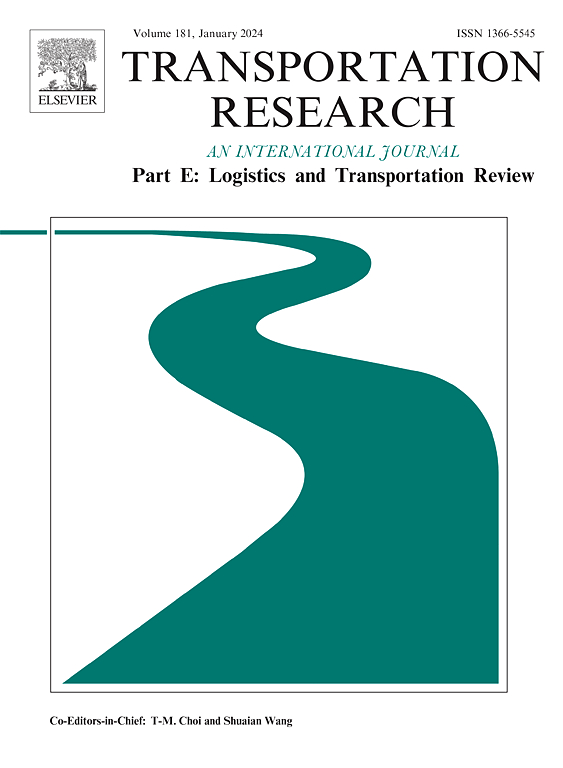城市范围内交付需求的联合估计和预测:基于图的学习方法的大型语言模型
IF 8.3
1区 工程技术
Q1 ECONOMICS
Transportation Research Part E-Logistics and Transportation Review
Pub Date : 2025-03-25
DOI:10.1016/j.tre.2025.104075
引用次数: 0
摘要
电子商务和城市化的发展大大加剧了城市地区的快递业务,增加了快递需求的数量和复杂性。数据驱动的预测方法,特别是那些利用机器学习技术的方法,已经出现,以处理城市交付需求管理问题中的这些复杂性。一个特别紧迫的问题尚未得到充分解决,那就是对整个城市交付需求的联合估计和预测,以及将该模型推广到新城市。为此,我们将这个问题表述为一个可转移的基于图的时空学习任务。首先,建立了个体-集体信息传递神经网络模型,以捕获相关区域需求模式之间的相互作用。其次,通过利用大型语言模型(llm)的最新进展,我们使用llm生成的嵌入从非结构化位置数据中提取一般地理空间知识编码。最后,为了鼓励模型的跨城市推广,我们以可转移的方式将编码整合到需求预测器中。在中国和美国8个城市的两个真实交付数据集上进行的综合实证评估结果表明,我们的模型在准确性、效率和可转移性方面明显优于最先进的基线。PyTorch的实现可在:https://github.com/tongnie/IMPEL。本文章由计算机程序翻译,如有差异,请以英文原文为准。
Joint estimation and prediction of city-wide delivery demand: A large language model empowered graph-based learning approach
The proliferation of e-commerce and urbanization has significantly intensified delivery operations in urban areas, boosting the volume and complexity of delivery demand. Data-driven predictive methods, especially those utilizing machine learning techniques, have emerged to handle these complexities in urban delivery demand management problems. One particularly pressing issue that has yet to be sufficiently addressed is the joint estimation and prediction of city-wide delivery demand, as well as the generalization of the model to new cities. To this end, we formulate this problem as a transferable graph-based spatiotemporal learning task. First, an individual-collective message-passing neural network model is formalized to capture the interaction between demand patterns of associated regions. Second, by exploiting recent advances in large language models (LLMs), we extract general geospatial knowledge encodings from the unstructured locational data using the embedding generated by LLMs. Last, to encourage the cross-city generalization of the model, we integrate the encoding into the demand predictor in a transferable way. Comprehensive empirical evaluation results on two real-world delivery datasets, including eight cities in China and the US, demonstrate that our model significantly outperforms state-of-the-art baselines in accuracy, efficiency, and transferability. PyTorch implementation is available at: https://github.com/tongnie/IMPEL.
求助全文
通过发布文献求助,成功后即可免费获取论文全文。
去求助
来源期刊
CiteScore
16.20
自引率
16.00%
发文量
285
审稿时长
62 days
期刊介绍:
Transportation Research Part E: Logistics and Transportation Review is a reputable journal that publishes high-quality articles covering a wide range of topics in the field of logistics and transportation research. The journal welcomes submissions on various subjects, including transport economics, transport infrastructure and investment appraisal, evaluation of public policies related to transportation, empirical and analytical studies of logistics management practices and performance, logistics and operations models, and logistics and supply chain management.
Part E aims to provide informative and well-researched articles that contribute to the understanding and advancement of the field. The content of the journal is complementary to other prestigious journals in transportation research, such as Transportation Research Part A: Policy and Practice, Part B: Methodological, Part C: Emerging Technologies, Part D: Transport and Environment, and Part F: Traffic Psychology and Behaviour. Together, these journals form a comprehensive and cohesive reference for current research in transportation science.

 求助内容:
求助内容: 应助结果提醒方式:
应助结果提醒方式:


